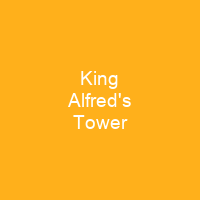King Alfred’s Tower, also known as The Folly of King Alfred the Great or Stourton Tower, is a folly tower. The 49-metre-high triangular tower has a hollow centre and is climbed by means of a spiral staircase in one of the corner projections. Henry Hoare II planned the tower in the 1760s to commemorate the end of the Seven Years’ War against France.
About King Alfred’s Tower in brief

It is the start of the Leland Trail, a 28-mile footpath which runs from the tower to Ham Hill Country Park. The triangular tower is over 40 metres high with a girth of 51 metres. Each of the three corners of the triangular structure has a round projection. The centre of the tower is hollow and to stop birds from entering the space a mesh has been added at roof level.
You want to know more about King Alfred’s Tower?
This page is based on the article King Alfred’s Tower published in Wikipedia (as of Nov. 26, 2020) and was automatically summarized using artificial intelligence.







